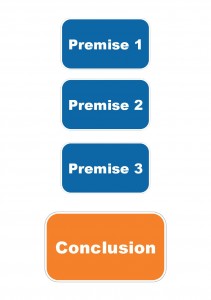Definition
Argument is series of sentences, statements, propositions where some are the premises and one is the conclusion and where the premises are intended to give a reason for the conclusion.
Visualization of the definition
There are two types of arguments
Deductive argument – It is an argument that is presented to be valid. Therefore, it cannot have a false conclusion when it is possible that all of its premises are true.
Example: All humans have brain. I am human. So, I have brain.
Inductive arguments – It is an argument that strength comes in degrees. It is NOT supposed to be valid. Inductive arguments are defeasible, which means they might be strong or weak, but not true or false.
Types of inductive arguments – Statistical Generalizations, Causal Reasoning, Probability, Inference to Best Explanation or Arguments from Analogy.
How to spot arguments? Argument markers
Arguments are made of language. As Aristotle stated many years ago, humans are the only animals that can use the language complex enough to form arguments.
That is why we can spot arguments by observing the language that creates them. There are two groups of argument markers.
Conclusion markers – “So”, ”Therefore”, ”Thus” or “Hence”. They indicate that the sentence that follows is the conclusion of the argument.
Reason markers – ”Because”, ”For”, ”As”, ”For the reason that”, “Since”. The reasons follow after them.
Note: Since the language is a complex tool of communication, these are NOT always argument markers. If you have any doubt about the word that indicate reason marker, simply substitute it by “because” and observe if the meaning stays the same.
Purpose
It is, again, Aristotle who established teleological reasoning in the philosophy (reasoning about the purpose of social phenomenon). Thus, the argument has also different purposes you can use them.
1. Persuasion – to make people believe or do something that they would not otherwise believe or do.
2. Justification – to support already established conclusion by giving reasons for it.
3. Explanation – to give a reason why something happened or why something is true.
By understanding purposes of used arguments, you can evaluate them more easily and critically as well.
Structure of argument in the debate
In the debate, however, it is not so easy to use a simple structure of the argument as above. Arguments deployed in the debate are more complex sets of ideas and thus required more complex structure. On the other hand, the definition stays the same. Your premises have to establish one concrete conclusion.
Many texts about debating use different ways how to create arguments in the debate. We would propose the guideline like this:
1. Basic statement of your argument
2. Explanation of processes and principles behind the statement
3. Examples or evidence that supports your statement or explanation
4. Link to the motion of the debate (“Why is your argument relevant for the debate?”).
This structure should help you to build your own arguments in the debate. It covers important aspects of the debate and it is logically coherent.
Examples
The best way how to see the arguments in the debate is to look through the former debates on AEGEEDebate. There you can critically assess the strength of arguments used according to above mentioned methodology. Useful examples of such debates are here or here.



[...] What is argument? [...]